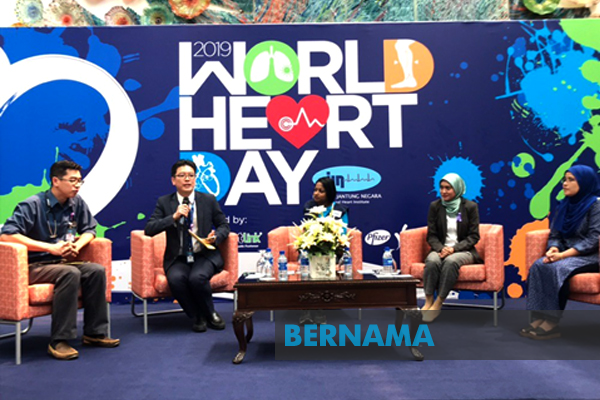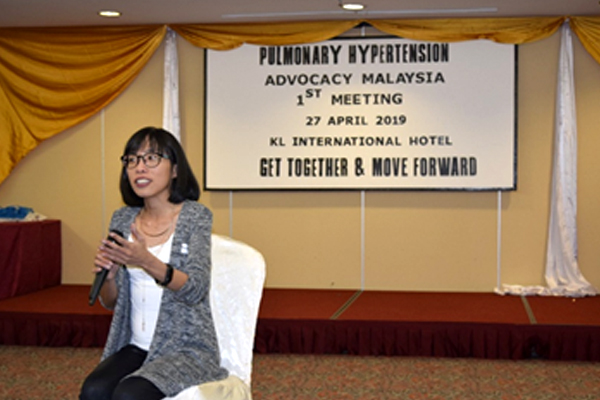Coping With Pulmonary Hypertension

By Nurhumairra Adnan
KUALA LUMPUR (Bernama) -- Creative director Cheah Pih Nyuk was about 19 when she found herself getting tired very quickly. Even the slightest exertion would leave her gasping for breath.
The general practitioners who she consulted advised her to exercise more, which was not really the solution as she always ended up feeling more tired than before.
Cheah, who is now 36, said it took doctors a good 10 years to diagnose her condition, namely pulmonary hypertension (PH).
PH is a type of high blood pressure that occurs when the arteries and capillaries in the lungs get narrower or become blocked or damaged. When this happens, blood flow from the right side of the heart to the lungs is affected. The pressure in the arteries concerned increases and the right side of the heart has to work harder to pump blood to the lungs. Over time, the condition will cause the right heart muscle to weaken.
Currently, there is no cure for PH but it can be managed via a rather costly treatment regime.

Cheah Pih Nyuk during the first PHAM sharing session.
Cheah said she made changes to her lifestyle to enable her to cope with the disease better.
"I know my limitations when I carry out my daily activities. To ensure my breathing remains smooth, I walk slowly and avoid getting into situations that will make me feel stressed.
"I also observe a healthy diet and stay away from salty food. I've to limit my water intake as well to avoid water retention in my body. If the water content is high, my abdomen gets bloated and my feet swell which makes it difficult for me to walk," she said.
Nur Zarifah Syahirah Zainudin, 17, who just completed her Sijil Pelajaran Malaysia examination, also has PH.
She had to opt for homeschooling as she always felt tired and fainted often.
Her mother Noor Hashimah Md Nor said due to her daughter's condition, she could not participate in outdoor activities like swimming or cycling, or go out with her friends.
RARE DISEASE
Another person with the same condition K. Kogilawathy@Mahimavathi, 34, had to quit her job as a nurse at a private hospital after working there for 13 years as she found her work physically taxing.
Kogilawathy, who was diagnosed of PH in January this year, said initially she remained inactive most of the time as she was afraid she might become breathless and her body may feel numb due to poor blood circulation.
"I felt like a living corpse... I kept to myself and cried a lot and refused to meet people. As I wasn't earning any longer, I kept worrying about my high cost of treatment. I became depressed," she said.
Fortunately for Kogilawathy, she felt better about herself after she read the accounts of other people who also have PH.
"With God's grace, I made an effort to stop complaining and to think positively. It changed my life and I was able to face the challenges that came my way," she said.
According to National Heart Institute (IJN) consultant cardiologist Dr Teoh Chee Kiang, PH is a rare disease and that there was only an estimated 10 to 52 cases per million population worldwide.
In Malaysia, which has a population of 32.6 million, 320 to 1,500 people are suffering from PH, he said.
He said PH occurs when the pulmonary arteries and lung capillaries become narrow and it gets harder for blood to flow through them. This raises the blood pressure in the lungs.
"The function of the pulmonary arteries is to pump blood from the heart to the lungs. When the arteries become narrower, the blood doesn't flow smoothly and this affects the pumping of oxygenated blood to the whole body by the heart," he said.
NOT EASY TO DIAGNOSE
According to Dr Teoh, a heart specialist would need at least 14 months to diagnose whether or not a person has PH, even after the patient has completed a battery of tests, such as chest X-ray, echocardiogram, ultrasound and electrocardiogram (ECG).
"Out of these tests, the echocardiogram is the most accurate when it comes to detecting PH," he said.
He said it is not easy for general practitioners to diagnose PH because its symptoms, such as fatigue, chest pain or discomfort, frequent blackouts and fainting spells and palpitations, also match that of other diseases.
IJN consultant paediatric cardiologist Dr Leong Ming Chern, meanwhile, said PH can be classified into five groups, depending on the cause.
The first group comprises pulmonary arterial hypertension or idiopathic pulmonary arterial hypertension, the cause of which is unknown, and heritable pulmonary arterial hypertension, as well as PH caused by congenital heart disease; connective tissue disorders such as lupus and scleroderma; and HIV infection and certain toxins.
The second group consists of PH caused by left-sided heart disease and the third, PH caused by lung disease. The fourth group is made up of PH caused by chronic blood clots in the lungs and the fifth, PH associated with other conditions such as sickle cell anaemia.
"For many patients, PH classified in the first group can emerge suddenly, thus making it difficult for the doctor to diagnose the disease although PH has been classified (into groups). This is why I always advise the public to get an echocardiogram done in the early stages," said Dr Leong.
He hoped for more public awareness of PH so that people who manifest symptoms linked to the disease can seek treatment earlier.
HIGH COST OF TREATMENT
The cost of diagnosing and treating PH can be rather high. According to Dr Teoh, tests like echocardiogram and ECG alone can cost between RM20,000 and RM25,000.
In terms of medication, the patient will need two types of drugs to reduce the pressure in the lungs. Their prices are steep too, with the monthly bill for both the drugs coming to RM13,500.
Meanwhile, a group of people with PH have come together to set up an association to provide support to fellow PH patients.
Pulmonary Hypertension Advocacy Malaysia (PHAM), formed in April 2019, is headed by Ruhana Md Zaki. A 12-member committee was appointed at its first meeting in April.
"PHAM's membership comprises PH patients. Only a patient can understand this disease well," she said, adding that the committee would visit hospitals where PH patients are being treated to provide them with counselling services and moral support.
She said PHAM would also extend financial assistance to needy patients once it has enough funds of its own.
They are also planning to travel all over the country to meet up with PH patients, she said.
"The sharing of information on PH can help patients as they need the support and understanding of the community around them. Community support will give them the strength to inspire other patients," added Ruhana.
Kogilawathy is among PHAM members who are extending a helping hand to fellow PH patients and their families to enable them to understand and cope with the disease better.
"It's my hope that we will get access to our medication at subsidised prices. It will help people like me who can't work and whose family members are in the low-income category," she added.
For more information on PH, go to https://www.facebook.com/Pulmonaryhypertensionadvocaymalaysia.
Translated by Rema Nambiar
-- BERNAMA
HealthEdge
EXCLUSIVE

Pet Vaccination, Public Awareness And Surveillance Key Towards Rabies-free Southeast Asia - Experts
KUCHING, Dec 11 (Bernama) -- The goal of making Southeast Asia free from human rabies can be achieved through a total understanding of the disease, how it can be prevented and responsible pet ownership among communities, say experts.
read more ››IN FOCUS

TAVI KAEDAH BAIK PULIH INJAP JANTUNG TANPA PEMBEDAHAN



